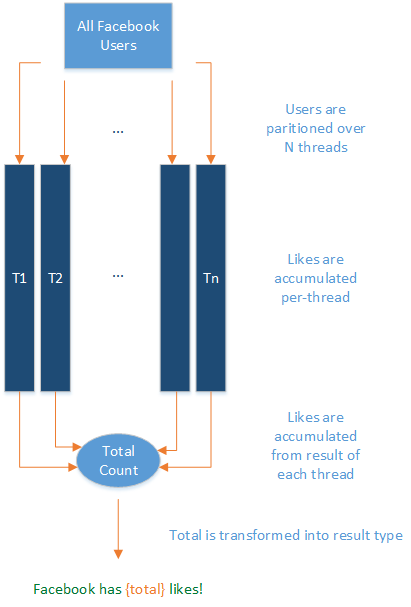网站首页 文章专栏 【转】MSDN LINQ概述
linq概述
语言集成查询 (LINQ) 为 C# 和 Visual Basic 提供语言级查询功能和高阶函数 API,让你能够编写具有很高表达力度的声明性代码。
语言级查询语法
语言级查询语法如下:
var linqExperts = from p in programmers
where p.IsNewToLINQ
select new LINQExpert(p);
同一个示例使用 IEnumerable<T> API 的情况如下:
var linqExperts = programmers.Where(p => p.IsNewToLINQ)
.Select(p => new LINQExpert(p));
LINQ 具有很高的表达力度
假设你有一份宠物列表,但想要将它转换为字典,以便可以使用宠物的 RFID 值直接访问宠物信息。
传统的命令性代码如下:
var petLookup = new Dictionary<int, Pet>();
foreach (var pet in pets)
{
petLookup.Add(pet.RFID, pet);
}
代码的意图不是创建新的 Dictionary<int, Pet> 并通过循环在其中添加条目,而是将现有列表转换为字典! LINQ 维持这种意图,而命令性代码则不会。
等效的 LINQ 表达式如下:
var petLookup = pets.ToDictionary(pet => pet.RFID);
使用 LINQ 的代码非常有效,因为在程序员的推理过程中,LINQ 能够在意图与代码之间找到合理的平衡。 另一个好处就是精简代码。 想像一下,如果能够像上面一样将大部分的基本代码减掉 1/3,情况会怎样? 真好,对吧?
LINQ 提供程序简化数据访问
对于生产环境中的软件,其重要功能块的任务不外乎就是来自某些源(数据库、JSON、XML 等)的数据。 通常,这就需要用户学习每个数据源的新 API,而这是一个枯燥的过程。 LINQ 可将用于数据访问的常用元素抽象化成查询语法,不过你选择哪种数据源,这种语法看上去都是相同的,因而简化了此任务。
这将查找具有特定属性值的所有 XML 元素:
public static IEnumerable<XElement> FindAllElementsWithAttribute(XElement documentRoot, string elementName,
string attributeName, string value)
{
return from el in documentRoot.Elements(elementName)
where (string)el.Element(attributeName) == value
select el;
}
为了执行此任务而编写代码来手动遍历 XML 文档会带来重重困难。
LINQ 提供程序的作用不仅仅是与 XML 交互。 Linq to SQL 是适用于 MSSQL Server 数据库的极其简练的对象关系映射器 (ORM)。 使用 Json.NET 库可以通过 LINQ 有效遍历 JSON 文档。 此外,如果没有哪个库可以解决你的需要,你还可以编写自己的 LINQ 提供程序)!
使用查询语法的理由
为什么要使用查询语法? 这是用户经常提出的一个问题。 无论如何,对于下面的代码:
var filteredItems = myItems.Where(item => item.Foo);
要比下面的代码简洁得多:
var filteredItems = from item in myItems
where item.Foo
select item;
难道 API 语法不比查询语法更简洁吗?
不是。 查询语法允许使用 let 子句,这样,便可以在表达式的作用域内引入和绑定变量,然后在表达式的后续片段中使用该变量。 只使用 API 语法重现相同的代码也是可行的,不过,这很可能会导致代码难以阅读。
那么,问题来了,只使用查询语法可以吗?
在以下情况下,此问题的答案是可以:
- 现有的基本代码已使用查询语法。
- 由于复杂性的问题,需要在查询中限定变量的作用域。
- 你偏好使用查询语法,并且它不会使基本代码变得混乱。
在以下情况下,此问题的答案是不可以…
- 现有的基本代码已使用 API 语法
- 不需要在查询中限定变量的作用域
- 你偏好使用 API 语法,并且它不会使基本代码变得混乱
基本 LINQ
有关 LINQ 示例的完整列表,请访问 101 个 LINQ 示例。
以下示例简单演示了 LINQ 的一些重要片段。 没有办法演示完整的代码,因为 LINQ 提供的功能比此处演示的要多。
语句构成 - Where、Select 和 Aggregate
// Filtering a list.
var germanShepherds = dogs.Where(dog => dog.Breed == DogBreed.GermanShepherd);
// Using the query syntax.
var queryGermanShepherds = from dog in dogs
where dog.Breed == DogBreed.GermanShepherd
select dog;
// Mapping a list from type A to type B.
var cats = dogs.Select(dog => dog.TurnIntoACat());
// Using the query syntax.
var queryCats = from dog in dogs
select dog.TurnIntoACat();
// Summing the lengths of a set of strings.
int seed = 0;
int sumOfStrings = strings.Aggregate(seed, (s1, s2) => s1.Length + s2.Length);
平展列表的列表
// Transforms the list of kennels into a list of all their dogs.
var allDogsFromKennels = kennels.SelectMany(kennel => kennel.Dogs);
两个集之间的联合(使用自定义比较运算符)
public class DogHairLengthComparer : IEqualityComparer<Dog>
{
public bool Equals(Dog a, Dog b)
{
if (a == null && b == null)
{
return true;
}
else if ((a == null && b != null) ||
(a != null && b == null))
{
return false;
}
else
{
return a.HairLengthType == b.HairLengthType;
}
}
public int GetHashCode(Dog d)
{
// Default hashcode is enough here, as these are simple objects.
return d.GetHashCode();
}
}
...
// Gets all the short-haired dogs between two different kennels.
var allShortHairedDogs = kennel1.Dogs.Union(kennel2.Dogs, new DogHairLengthComparer());
两个集之间的交集
// Gets the volunteers who spend share time with two humane societies.
var volunteers = humaneSociety1.Volunteers.Intersect(humaneSociety2.Volunteers,
new VolunteerTimeComparer());
中间件排序
// Get driving directions, ordering by if it's toll-free before estimated driving time.
var results = DirectionsProcessor.GetDirections(start, end)
.OrderBy(direction => direction.HasNoTolls)
.ThenBy(direction => direction.EstimatedTime);
实例属性的相等性
最后,我们演示一个更高级的示例:确定相同类型的两个实例的属性值是否相等(该示例摘自此 StackOverflow 文章,不过已做修改):
public static bool PublicInstancePropertiesEqual<T>(this T self, T to, params string[] ignore) where T : class
{
if (self == null || to == null)
{
return self == to;
}
// Selects the properties which have unequal values into a sequence of those properties.
var unequalProperties = from property in typeof(T).GetProperties(BindingFlags.Public | BindingFlags.Instance)
where !ignore.Contains(property.Name)
let selfValue = property.GetValue(self, null)
let toValue = property.GetValue(to, null)
where !Equals(selfValue, toValue)
select property;
return !unequalProperties.Any();
}
PLINQ
PLINQ(又称并行 LINQ)是 LINQ 表达式的并行执行引擎。 换言之,LINQ 正则表达式可能会没有意义地在任意数量的线程之间并行化。 为此,可以调用表达式前面的 AsParallel()。
考虑以下情况:
public static string GetAllFacebookUserLikesMessage(IEnumerable<FacebookUser> facebookUsers)
{
var seed = default(UInt64);
Func<UInt64, UInt64, UInt64> threadAccumulator = (t1, t2) => t1 + t2;
Func<UInt64, UInt64, UInt64> threadResultAccumulator = (t1, t2) => t1 + t2;
Func<Uint64, string> resultSelector = total => $"Facebook has {total} likes!";
return facebookUsers.AsParallel()
.Aggregate(seed, threadAccumulator, threadResultAccumulator, resultSelector);
}
此代码将会根据需要在系统线程之间将 facebookUsers 分区,累加每个并行线程上的类似项总计,累加每个线程计算的结果,然后将该结果投影为一个合理的字符串。
图示:

可通过 LINQ 能够轻松表达的可并行化 CPU 密集型作业(即,没有副作用的纯函数)非常适合使用 PLINQ 来处理。 对于确实有副作用的作业,请考虑使用任务并行库。
